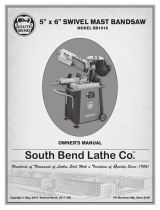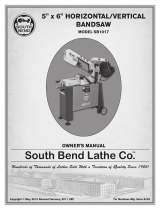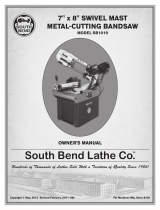
Owner’s / Operator’s Manual
Weed Raker
Model # WRK09
Ref. Number Part Number Description Quantity
1 WRKRH09 Rake Head 1
2 WRKEC09 End Cap 2
3 WRKBH09 2” Bolt, and nut 4
4 WRKTS09 Tines (teeth) 12 pairs
5 WRKHF09 Handle section for Rake head 1
6(a,b) WRKSB09 Support Bracket 2
7 WRKHC09 Handle Connector 3
8 , 9 WRKHD09 Handle 3
10 WRKBE09 1.75” Bolt, and nut 1
11 WRKBC09 Black end cap 1
12 WRKRP09 Rope 1
Please refer to the Ref. Number when assembling the tool and Part Number when placing order for replacement part
Parts List

Assembly Instruction
Place one end cap (2), into the Rake Head (1). Secure the end cap with the bolt and lock nut (3). Insert rake teeth (4) into the
channel at the bottom of the rake head and slide down to the end cap(there are 12 pairs of teeth). The teeth should curve toward
the handle. When all of the teeth have been inserted, insert the second end cap (2) into the rake head and secure in place with
the bolt and lock nut (3).
Slide the section of the handle with a tapered end (5) into the oval hole in the rake head (1) (see diagram). The handle should
only pass through the oval hole far enough so the first bolt hole is completely visible on the other side of the rake head. Line the
support brackets (6a,b) up with the bolt holes on the handle. Insert the two bolts (3) from the bottom of the handle up through the
holes in the handle and support brackets. Secure the bolts with the lock nuts and tighten until they are snug.
Connect the remaining sections of the handle (8) to the handle section (5) using the handle connector pieces (7). Pinch the
spring loaded clip on one end of the connector piece to insert it into the handle. Rotate the connector piece until the spring clip
snaps into the holes in the handle. Complete the assembly by inserting handle section (9). Insert the looped end of the rope
through the black cap(11) on the end of the handle (9) until the loop lines up with the bolt hole in the end of the handle. Insert bolt
(10) through both the hole in the handle and the loop in the rope. Pull on the rope to confirm the bolt passed through the end of
the rope loop. Secure the bolt in place with the lock nut. Over-tightening the bolt will bend the end of the handle. A heavy fish line
can be threaded through the perforated ends of the rake teeth to increase the rakes cutting and pulling action. (Fish line is not
included).
6b
6a
8
9
10 7
3
4
2
1
2
3
11
5
Operating Instruction
The Weed Raker is designed to remove:
weed roots to prevent re-growth
cut weeds and debris floating on the surface of the water
shorter bottom-dwelling weeds
decaying organic matter on the bottom.
If you have recently cut your weeds with the Weed Razer, use the Weed Raker
to remove the remaining roots that lie beneath the surface of your lake or pond
bottom. Allow the Raker head to sink to the bottom. Use a back and forth mo-
tion with the Raker handle and stir up the bottom. The long teeth of the Weed
Raker will dig into the bottom and dislodge the root systems of most leafy sub-
mergent aquatic vegetation. See Figure 1 and 2.
The head of the Weed Raker can be weighted by putting small rocks into either
end of the Raker head. Removing the end caps (2) from the Raker head, insert-
ing the rocks and replace the end caps. The Weed Raker can be used with or
without the rope.
The large Raker head is ideal for gathering and moving piles of cut weeds. The
Weed Raker can also be used as a cutting tool. Thread a heavy fish line through
the perforated tips of the Weed Raker’s teeth. Secure the line on both ends.
Weigh down the Raker head. Toss the Raker into an area where you want to
remove short weeds. Let the Raker sink to the bottom. Retrieve the Raker with
jerking motions. The line will cut the vegetation in its path with each pull.
Figure 1
Figure 2
/



